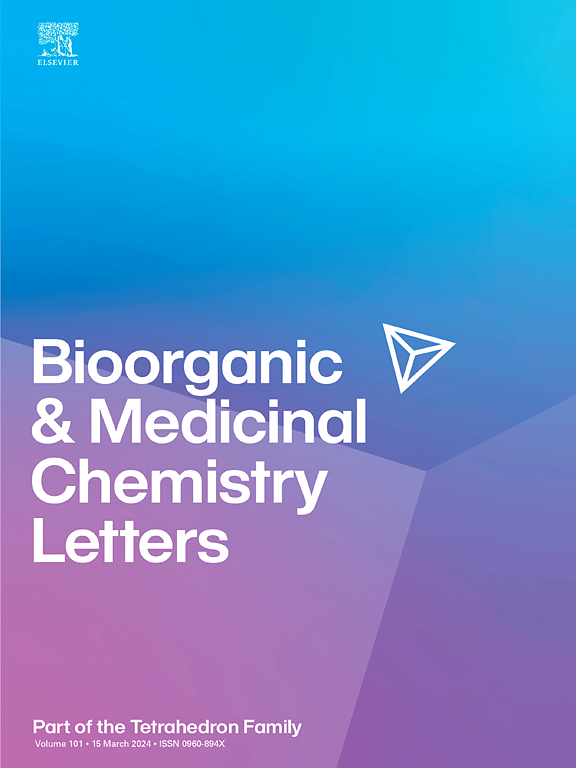咪唑[1,2-a]吡啶系列的构效关系探索以逆转同工异构体选择性并鉴定有效的SIK1选择性抑制剂。
IF 2.2
4区 医学
Q3 CHEMISTRY, MEDICINAL
引用次数: 0
摘要
盐诱导激酶(SIK)家族包括三个亚型,SIK1, SIK2和SIK3,它们是amp活化蛋白激酶(AMPK)家族丝氨酸/苏氨酸蛋白激酶的成员。由于SIKs调节多种生理过程,如代谢、骨重塑、免疫反应、恶性肿瘤、皮肤色素沉着和昼夜节律,SIK抑制已成为一种潜在的治疗方法,可用于多种适应症。在同种异构体特异性SIK抑制剂中,有必要了解每种蛋白质的独特作用,在这里我们描述了第一种SIK1选择性抑制剂。从表现出泛sik抑制的高通量筛选(HTS)开始,结构-活性关系(SAR)研究导致鉴定出苯基环上的取代模式,该模式增加了对SIK1的效力以及对SIK2和SIK3的选择性。进一步优化同种异构体的选择性,得到了化合物27,这是一种亚纳摩尔的SIK1抑制剂,在生化实验中对SIK2和SIK3的选择性超过100倍。27的异构体选择性在细胞环境中得到证实。化合物27的鉴定为研究SIK1在SIKs介导的生物过程中的作用提供了一个SIK1选择性化合物;然而,27对其他激酶的活性,特别是酪氨酸激酶,在数据解释时不应忽视。本文章由计算机程序翻译,如有差异,请以英文原文为准。
![Structure activity relationship exploration of imidazo[1,2-a]pyridine series to reverse isoform selectivity and identify potent SIK1 selective inhibitors](https://img.booksci.cn/booksciimg/2025-9/104309352341789594297.jpg)
Structure activity relationship exploration of imidazo[1,2-a]pyridine series to reverse isoform selectivity and identify potent SIK1 selective inhibitors
The salt-inducible kinase (SIK) family encompasses three isoforms, SIK1, SIK2, and SIK3, which are members of the AMP-activated protein kinase (AMPK) family of serine/threonine protein kinases. SIK inhibition has emerged as a potential therapeutic approach across multiple indications, as SIKs regulate a diverse set of physiological processes such as metabolism, bone remodeling, immune response, malignancies, skin pigmentation, and circadian rhythm. Within isoform-specific SIK inhibitors there is a need to understand the distinct role of each protein, and here we describe the first SIK1 selective inhibitors. Beginning with a high-throughput screening (HTS) hit that exhibited pan-SIK inhibition, structure-activity relationship (SAR) investigation led to the identification of a substitution pattern on a phenyl ring that increased both potency on SIK1 and selectivity against SIK2 and SIK3. Further optimization of isoform selectivity led to compound 27, a subnanomolar inhibitor of SIK1 in biochemical assays that exhibited more than 100-fold selectivity against SIK2 and SIK3. Isoform selectivity of 27 was confirmed in a cellular context. Identification of compound 27 provided a SIK1-selective compound to investigate the role of SIK1 in biological processes mediated by SIKs; however, activity of 27 on other kinases, in particular tyrosine kinases, should not be neglected upon data interpretation.
求助全文
通过发布文献求助,成功后即可免费获取论文全文。
去求助
来源期刊
CiteScore
5.70
自引率
3.70%
发文量
463
审稿时长
27 days
期刊介绍:
Bioorganic & Medicinal Chemistry Letters presents preliminary experimental or theoretical research results of outstanding significance and timeliness on all aspects of science at the interface of chemistry and biology and on major advances in drug design and development. The journal publishes articles in the form of communications reporting experimental or theoretical results of special interest, and strives to provide maximum dissemination to a large, international audience.

 求助内容:
求助内容: 应助结果提醒方式:
应助结果提醒方式:


